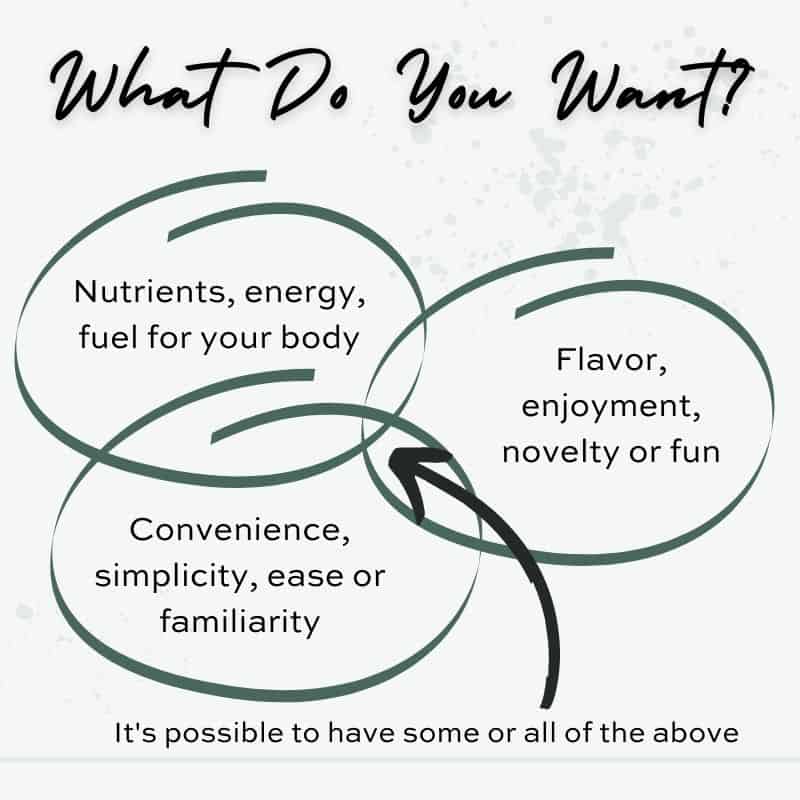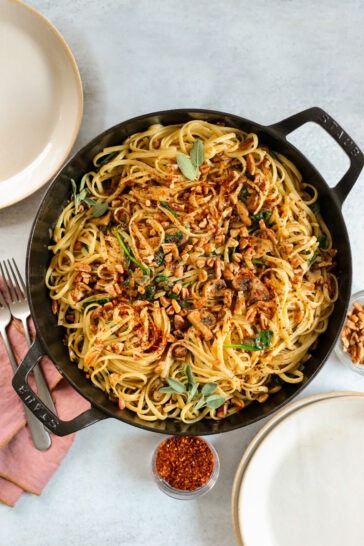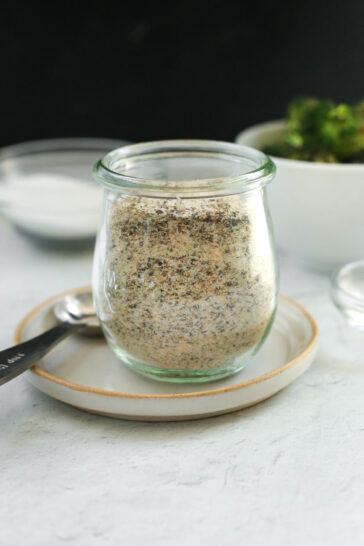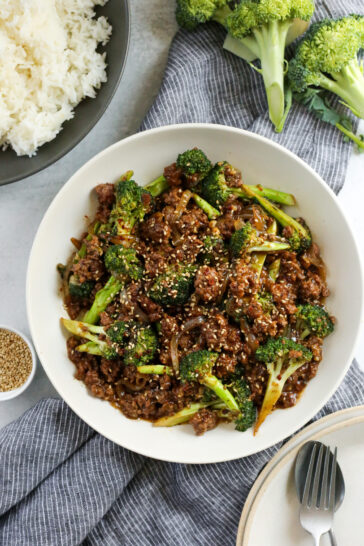Self-care can do so much to support overall health and well-being. It doesn’t have to be complicated or time-consuming! Read my top three tips for building consistent self-care practices using foods you love that love you back.
Disclosure: This post was written in partnership with Potatoes USA. I was compensated for my time. As always, thank you for supporting the brands that support Street Smart Nutrition!
What do you think of when you hear the word “health”?
If you asked me that question five or ten years ago, my answer would look completely different than it does today. Back then, I really believed physical health reigned supreme. After all, I was on my way to becoming a dietitian and totally preoccupied with which foods were considered “healthy” and “unhealthy.”
But now, I’ve learned so much more about what “health” really looks like in practice. As the graphic above shows, it’s much more than physical health. It’s also emotional and mental health, financial health, the health of our relationships and support system, and the environment we live in (just to name a few).
As my definition of health evolved, so did my idea of healthy behaviors and habits. “Health enhancement” is one of the key pillars of Health at Every Size® (HAES®) which you can read more about on this updated page from the Association of Size Diversity and Health(1). As a weight-inclusive, non-diet dietitian, these HAES® principles guide my practice and how I talk about health.
The one we’ll focus on today is self-care! In other words, the “personal practices that improve human well-being, including attention to individual physical, economic, social, spiritual, emotional and other needs.” After all, spring is a great time for self-reflection and to refocus on self-care, including shifting your mindset away from harmful or limiting food beliefs.
Three Tips to Make Healthy Habits Stick
I encourage you to think about how you can move away from black and white, all-or-nothing beliefs when it comes to health.
For example, refraining from labeling foods as “good” or “bad” and instead recognizing that all foods offer different things. Yes, there are nutritional differences (which I talk about often on this blog and in my work as a dietitian) but no food is morally better or worse based on that.
One of my favorite examples of this is the potato. Potatoes are one of my favorite foods for many reasons, including because they are nutrient-dense vegetables that have the energy, potassium, and vitamin C I need to fuel my day and the fact that they’re so versatile. I mean, how many different ways can you think of to prepare potatoes? And many of those preparations are accompanied by additional vegetables, proteins, social connections, family traditions, and other important pieces of overall health. Despite that, many people don’t often think of them as a “healthy” food, which couldn’t be further from the truth.
Now that I’ve shared an example, let’s take a look at three ways you can apply this to other parts of your life. Consistency is key to making new habits stick, so these could be a great place to start if you’re focused on supporting your health this year!
1. Habit Stacking
Just like the name implies, “habit stacking” refers to stacking a new or different habit on top of something you already do.
Take brushing your teeth: you probably already do this in the morning or at night, so if you wanted to create a habit around reading a book or journaling gratitude, you could “stack” that action before or after you brush your teeth. Over time, you create a consistent routine and strengthen the habit so it starts to feel more like second-nature, or something you do without extra planning.
When it comes to food, you might have a goal of adding more vegetables. Most Americans don’t eat the recommended number(2) of servings each day – could you “stack” a serving of vegetables with a food you already love and eat regularly? In my kitchen, I like to do this with potatoes. And…spoiler: it’s a double whammy because potatoes themselves are a nutrient-dense vegetable. Did you know potassium and dietary fiber continue to be under consumed nutrients(3) for just about everyone? That’s why “stacking” potatoes is a simple habit that may help close nutrient gaps.
How?
Potatoes are a food with one of the highest levels of potassium(4) (more than a medium-size banana(5)) and are a good source, providing 15% of the daily value per serving. In addition, they have 7% of the daily value of dietary fiber per serving.
You can read more about the health benefits of eating potatoes in this post!(6)
There are tons of veggie-forward dishes(7) that include potatoes, and – vice versa – potatoes are a great ingredient to add to a dish for an extra serving of vegetables. Stacking these ingredients together creates a great opportunity to add more nutrition to your meals and can build a healthy habit. Eating regularly and planning meals(8) can be a form of self-care in and of itself!
2. Reframe Negative or Critical Thoughts
If we hear something enough times, we start to believe it’s true (even if it’s not).
And since many of us are spending a lot of time socially distanced or feeling isolated these days, we hear our own thoughts more than ever. I encourage you to get curious about where judgment or criticism is showing up in your comments around food. Are there foods you enjoy eating but don’t allow yourself to have?
Food is so much more than fuel. Yes, we know that high-quality carbohydrates (like potatoes!) energize and fuel our bodies, but there’s a lot more to it than that. Food is also love, and comfort, and memories. Think back to your childhood – what are some foods you always looked forward to having? Or when you eat mashed potatoes, do you feel comforted and soothed? Was there a traditional dish from your family’s culture that could be celebrated, completely independent of the nutrition in the ingredients?
This is a great journaling exercise I sometimes ask clients to try. You can try it, too: just keep a note open in your phone (or pen and paper if you’re like me and like to do it the old-fashioned way) and jot down what you notice yourself thinking or saying about food and eating. Eventually, you’ll hone in on what feels critical or negative, or notice a pattern of when those thoughts show up more often.
From there, you can use the awareness you cultivated to start gently reframing them or offer yourself the chance to instill new beliefs about food and nutrition that are rooted in truth and facts. Those new beliefs can then drive new habits, which can be more sustainable for the long-term because they’re based on you and not what you think you should be doing for health.
3. Ditch the Food Rules
One of my all-time least favorite “food rules” was the advice to avoid eating white or beige foods. I absolutely hated hearing that, because so many of my favorite foods are indeed white or beige! Milk and yogurt, cauliflower, bread, rice, and of course, potatoes!
All of these foods contain energy and nutrients that our bodies can put to good use. Color has never been a reliable indicator of healthfulness and all colors from all vegetable groups, including white, should be welcome. Take potatoes, for example. I already shared some benefits of potato nutrition, but in a medium, skin-on potato you also get:
- Many important nutrients vital for health, including vitamin C. Potatoes are an excellent source of vitamin C, providing 30% of the recommended daily value.
- 3 grams of plant-based, complete protein which is more protein than other commonly consumed vegetables, except dried beans(9).
- 26 grams of carbohydrates to fuel you whether you’re working out or just running errands.
- Potatoes are affordable high-quality carbohydrate. They provide more nutrients per penny(10) than most other vegetables.
Rather than allowing your food choices to be directed by diets, food rules, or other external guides, turn inward and ask yourself, “What do I want to eat?”
Now, your answer to that might change based on where you are, what your budget looks like, and whether or not you want to cook (among other considerations). But that’s a good place to start if you want to feel less restricted or bound by food rules.
If this is a new approach for you, you may need to start at the very beginning and first ask yourself what your taste preferences really are. For instance, do you like creamy, smooth textures (like those mashed potatoes I mentioned earlier), or crispy, crunchy textures (think air-fried potatoes or homemade baked fries)? Do you prefer sweet flavors, or more savory, salty, or spicy? What about temperature? I really want my hot foods to be served hot and my cold foods to be served cold. Using potatoes as an example, you may be used to eating potatoes hot but consider venturing more into potato salads or cold potato preps!
Fun fact: potatoes even offer a type of starch known as “resistant starch” that can be greatly increased(11) during preparation (e.g., cooking and then chilling potatoes).
Once you get familiar or reacquainted with your taste preferences, you can put them into action! Use this information about your taste preferences to plan and prepare meals and snacks that are genuinely satisfying and filling to you (even if they don’t look like someone else’s version).
You might be surprised at how different it feels to try to maintain healthful eating habits when you actually like what you’re eating!
So there you have it! Three of my most-recommended suggestions for building self-care habits that stick.
I’m curious: what are some of the ways you build consistency around healthy eating habits? How do you use nutrition as a form of self-care?
If you’re looking for recipe inspiration as you explore your taste preferences (check out the recipes archives on PotatoGoodness.com.
References
- The Health at Every Size® (HAES®) Approach. The Association for Size Diversity and Health website. https://asdah.org/health-at-every-size-haes-approach/. Accessed March 25, 2021.
- Lee-Kwan SH, Moore LV, Blanck HM, Harris DM, Galuska D. Disparities in state-specific adult fruit and vegetable consumption — United States, 2015. MMWR Morb Mortal Wkly Rep. 2017;66:1241–1247.
- U.S. Department of Agriculture and U.S. Department of Health and Human Services. Dietary Guidelines for Americans, 2020-2025v. 9th Edition. December 2020. Available at DietaryGuidelines.gov.
- Food Sources of Potassium. USDA website. https://www.dietaryguidelines.gov/food-sources-potassium. Accessed March 25, 2021.
- U.S. Department of Agriculture, Agricultural Research Service. FoodData Central, 2019. fdc.nal.usda.gov.
- Harbstreet C. Potatoes Are A Good Carb! Three Reasons to Put Them on Your Plate. Street Smart Nutrition website. https://streetsmartnutrition.com/health-benefits-of-eating-potatoes/. Published February 24, 2021. Accessed March 25, 2021.
- Potato Recipes. Potato Goodness website. https://www.potatogoodness.com/potato-recipes/. Accessed March 25, 2021.
- Harbstreet C. What You Need to Know About Meal Planning And Intuitive Eating. Street Smart Nutrition website. https://streetsmartnutrition.com/meal-planning-intuitive-eating/. June 10, 2019. Accessed March 25, 2021.
- Woolfe JA, Poats S. The potato in the human diet. Cambridge University Press, 1987.
- Drewnowski A. New metrics of affordable nutrition: which vegetables provide most nutrients for least cost? J Acad Nutr Diet. 2013;113(9):1182-7.
- Raatz SK, et al. Resistant starch analysis of commonly consumed potatoes: Content varies by cooking method and service temperature but not by variety. Food Chemistry. 2016;208:297-300.


















Questions & Reviews